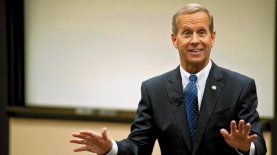HARRISBURG, Pa. - Without action to release appropriations that are eight months overdue, there will be profound changes to four universities that together educate more than 110, 000 Pennsylvanians each year.
That was the clear message Wednesday (March 2) from leaders of Penn State, Temple, Lincoln and the University of Pittsburgh during their appropriations hearings before the House and Senate, and in a press conference in the Capitol Rotunda. Among them, Penn State Provost and Executive Vice President Nicholas P. Jones, who was joined by Patrick Gallagher, University of Pittsburgh chancellor; Neil Theobald, Temple University president; and Richard Green, interim president at Lincoln University.
“To discuss future appropriations while still awaiting the current year’s funding is difficult, given that we are looking at a series of damaging impacts beginning with students and extending to programs, employees and the overall economic well-being and future of the Commonwealth due to the failure to come to a budget agreement in this current year, ” said Jones. “We are now eight months into our budget year and our four institutions can no longer fend off the effects of a combined $600 million loss in appropriations.”
While both parties in Harrisburg have agreed in their negotiations to a 5 percent increase in support for Penn State in 2015-16, and while Gov. Tom Wolf’s 2016-17 budget suggests another 5 percent increase, no funding has been forthcoming due to a budget impasse that has been ongoing since July. Each year, state appropriations are used to lower Penn State tuition for Pennsylvania resident students; support Agricultural Research and Extension operations that have a profound impact on the Commonwealth’s largest industry; and provide critical support for Pennsylvania College of Technology and the Penn State Hershey Medical Center.
“For more than 150 years, through economic booms and recessions, political constancy and change, the Commonwealth has provided financial support for a Penn State’s land-grant mission to benefit the citizens of Pennsylvania, ” said Penn State President Eric Barron, who was unable to attend the hearings, in written testimony. “We are at a crossroads, and how our lawmakers ultimately resolve the impasse will determine if Penn State’s mission remains the same, or evolves into something quite different.”
For the current fiscal year, Penn State alone is facing a $300 million appropriations shortfall.
Noting that Pennsylvania’s state-related universities are strong economic drivers across the Commonwealth, Sen. John Rafferty asked leaders during their hearing to reflect on the impact of the current budget challenges on retaining faculty and staff.
“People are our priority. We place a very high premium on keeping the great people that we have, ” Jones said. “Our deans and chancellors have placed a premium, even in these tight budget times, on ensuring that we are able to recruit the best faculty and staff. However, I will say that we are being raided - it is beginning already - other universities are looking at us and approaching our faculty and trying to lure them away.”
A number of legislators also asked specifically about the impact of a continued lack of support for Penn State’s Agricultural Research and Extension operations.
“It’s really with very heavy hearts that we put ourselves even in the position of planning for a phase-out of Agricultural Research and Extension, ” Jones said. “This is not something that any of us can remotely conceive given the length, depth and extent of the partnership that has existed between Penn State, the Commonwealth, Pennsylvania’s counties and the federal government.”
Unless legislators and the governor take expedient action to approve funding for Penn State, impacts on the university will be severe, including:
In response to the impact the lack of state funds will have on tuition, Jones said at this point, he is still hopeful the state will uphold its partnership with its state-related universities. However, given that the sources of funding for the educational mission of the universities is mostly limited to tuition and state appropriations, Jones said nothing is off the table and all options will be considered.
“We are truly concerned about the negative impact on students and their families, ” Jones said. “We know this is not a proposition we want to consider.”
Throughout the day, lawmakers asked leaders about their institutions’ efforts to reduce costs and efficiently spend taxpayer dollars. Penn State has enacted more than $360 million in cuts to recurring costs since 1992 as state appropriations for Penn State and other public and land-grant institutions have continued to decline. These savings include more than $34 million in budget reductions and estimate adjustments in the current fiscal year’s budget alone.
University leaders also discussed their ongoing efforts to reduce average student debt and cost-to-degree even in the face of decades of waning appropriations, including Plan4 Penn State, a collection of initiatives aimed at increasing retention and graduation; decreasing the total cost of a degree; decreasing the rate of borrowing and decreasing attrition due to the need for additional money to attend.











 Oakland is the academic, cultural, and healthcare center of Pittsburgh and is Pennsylvania's third largest "Downtown". Only Center City Philadelphia and Downtown Pittsburgh can claim more economic and social activity than Oakland. The neighborhood is urban and...
Oakland is the academic, cultural, and healthcare center of Pittsburgh and is Pennsylvania's third largest "Downtown". Only Center City Philadelphia and Downtown Pittsburgh can claim more economic and social activity than Oakland. The neighborhood is urban and...